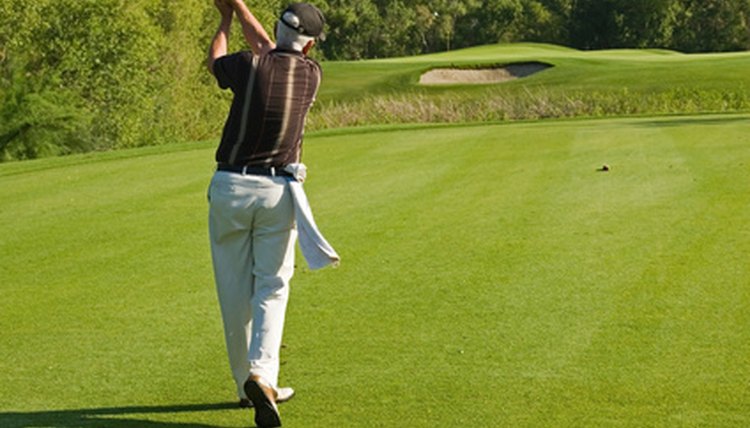Muscles Used in the Golf Swing

Some people think golf is a leisurely activity, but it offers a great all-around body workout. A properly, or even improperly, performed golf swing works muscles in the upper and lower body. Golfers should know the basic muscle groups engaged when playing golf and, most importantly, which muscles are used to create the perfect swing. Your golf game will improve, you'll burn calories and learn which muscles to focus on during regular exercise.
External Abdominal Obliques
These muscles help rotate the torso. The back is the driving force behind a golf swing, which incorporates the muscles that help you keep the ball on the fairway or onto the green. The three major muscles worked in the spine are the rotatores, the external abdominal obliques and the multifidus, according to Dr. Larry Van Such of Secrets of Speed and Quickness Training at Athletic Quickness. One of most important muscles for your golf swing is the external abdominal obliques, located along the side of the torso, covering the sides of the ribs from under the arm to the crest of the hip.
Gluteus Maximus
More commonly known as the buttocks, the gluteus maximus gives individuals the ability to rotate at the thighs as well as provide solid lower body support and stance with slightly bent knees during a golf swing. Tightening the buttocks prior to and during a swing helps keep the lower body still, providing a solid foundation for the duration of the swing.
Pectroalis Major
The pectoralis major, or chest muscle, extends from the sternum to the shoulder joint on each side of the chest and helps the shoulder flex and the arm extend. This muscle is vital for rotation and a smooth, effective golf swing.
Latissimus Dorsi
The latissimus dorsi muscle extends from underneath the armpit to the mid-level of the back, connecting to the ribs in the thoracic area and the scapula, or shoulder blade. This muscle works in conjunction with the pectoralis major, helping the arm to adduct, or move toward the body, and to rotate and extend, all muscle movements that are necessary to perform a golf swing.
Forearm
The muscles of the forearm are vital to a golf swing because a proper grip on the club is what drives the ball in the right direction. The major forearm muscles used in a golf grip include the flexor digiorum superficialis, which are top-level muscles found in the forearm, as well as deeper muscles such as the flexor digitorum profundus and the flexor pollicis longus. Each of these muscles help provide a strong and secure grip on the golf club.
References
- GetBodySmart.com: External Oblique Muscles
- Leslie E. Smith et al. Acute and Chronic Health Benefits of TRX® Suspension Training®. American Council on Exercise sponsored study. 2016
- Mayo Clinic Staff. Golf Stretches. The Mayo Clinic. 2018
- TRX Training. TRX For Golf: TRX Golf Swing (Opposite Hands). 2016
Writer Bio
Denise Stern is an experienced freelance writer and editor. She has written professionally for more than seven years. Stern regularly provides content for health-related and elder-care websites and has an associate and specialized business degree in health information management and technology.
